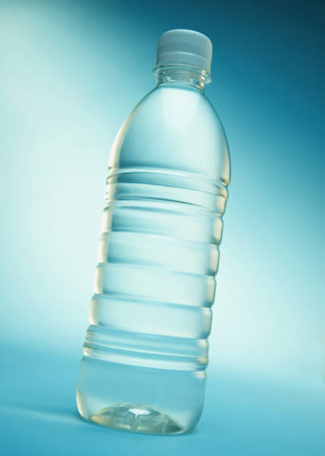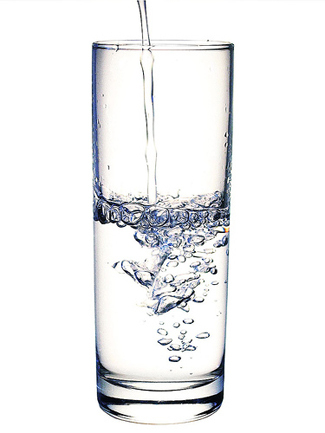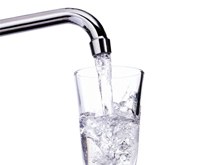| Share |  |
 | |||
The Wonders of Water - Part Two
 As we examined in last month's article on the "Wonders of Water," sufficient water intake is key to your health and vitality. To experience all the wonderful benefits of water, it is important to drink enough throughout the day and to consume water that is as pure as possible.
As we examined in last month's article on the "Wonders of Water," sufficient water intake is key to your health and vitality. To experience all the wonderful benefits of water, it is important to drink enough throughout the day and to consume water that is as pure as possible.
How Much to Drink
A good rule of thumb for determining how much water you need to drink each day is to divide your body weight in half and drink that amount in ounces throughout the day. It's a good idea to drink extra water if you are either exercising or engaged in any activity that makes you sweat or are in hot or humid weather or higher altitudes. More also may be needed if you are sick, under mental or emotional stress or pregnant. Try to avoid dehydrating beverages such as coffee, caffeinated soda and alcohol that act as a diuretic in the body. If you do consume these beverages, increase your water intake to compensate for that loss of fluid. Herbal teas and diluted fruit juices along with eating a good amount of fresh fruits and vegetables can add to meeting your body's requirement for water.
Keeping Hydrated Throughout the Day
Drinking a glass of water first thing in the morning acts as a good internal cleanser and rehydrates the body after an overnight fast. Drinking a glass 15-20 minutes before each meal (more before your largest meal) will help decrease appetite and keep excess liquid from diluting enzymes in your stomach and intestines during the digestive process as would occur if the majority of liquid intake was consumed with meals (see December issue article on "Digestion.") Having another glass a couple of hours after breakfast and again after lunch and dinner when the stomach is empty is beneficial for flushing out the stomach, intestines and kidneys so they can work at optimum efficiency. If a whole glass of liquid seems like too much or makes you feel bloated, drinking smaller amounts more frequently is fine as well. It may take concerted effort and even some planning on your part to develop the habit of drinking good quality water on a regular basis. Taking a container of pure water with you when you are away from home makes it more convenient and easy to remember to keep your system hydrated throughout the day.
Pure Water - A Challenge in Today's World
If water is to effectively benefit health, it is essential that it be pure and free of chemical and bacterial contaminants. In spite of the best efforts of water treatment plants, toxic residues of chemicals from the air, agricultural pesticides and fertilizers, heavy metals such as mercury and lead, prescription drugs, industrial and nuclear waste, acid rain, gas storage tank leakage, sewage, bacteria and other organisms continue to end up in our water supply in increasing amounts. Water purification plants are more focused on using disinfectants to reduce disease carrying germs but have done little to safeguard consumers from toxic chemicals. Though one thousand new chemicals are introduced in this country each year, only a hundred or so are addressed by the Federal Safe Drinking Water Act and we have yet to know the long-range health consequences of scores of them. To add to the problem, toxic compounds such as fluoride and chlorine are purposely added to our tap water, which come with their own health hazards.
Chlorine - the Good, the Bad and the Ugly
Chlorine, the primary cause of bad taste and odor in drinking water, was first introduced in the late 19th century as a water disinfectant in an effort to combat diseases like cholera and typhoid. Classified as a pesticide by the EPA, it is a highly toxic gaseous element whose sole purpose is to kill living organisms. It destroys cells and attacks delicate body tissues when it is consumed, breathed or absorbed through the skin. Used as a weapon in WWI, it was known to burn the lungs and other body tissues when inhaled.  Chlorine destroys vitamins such as A, B, C & E, key anti-oxidants that protect against heart disease and cancer, as well as good bacteria in our intestinal flora, further weakening the immune system. It also increases the risk of developing allergies, asthma and kidney stones.
Chlorine destroys vitamins such as A, B, C & E, key anti-oxidants that protect against heart disease and cancer, as well as good bacteria in our intestinal flora, further weakening the immune system. It also increases the risk of developing allergies, asthma and kidney stones.
More problematic than actual chlorine are the toxic chemical by-products created when it combines with volatile organic compounds such as decaying vegetation in the source water. Besides harmful substances like chloroform and nitrogen trichloride, carcinogenic and mutagenic chemicals known as trihalomethanes are produced which have been linked in studies with cancer of the colon, bladder and breast as well as heart disease and premature senility. It was found, for instance, that women with breast cancer had 50% to 60% higher levels of these organochlorines in their breast tissue than women without breast cancer. According to the U.S. Council of Environmental Quality, "Cancer risk among people drinking chlorinated water is 93% higher than among those whose water does not contain chlorine." To learn more information about the relationship of chlorine to cancer and heart disease and the toxicity of tap water, check this website: http://www.internethealthlibrary.com/Environmental-Health/Chlorine-and-cancer.htm
So what's the Problem with Showering?
The use of chlorine is likely to continue since its effectiveness as a powerful agent against parasites and disease-causing pathogens is undisputed and greater health risks from bacterial outbreaks would occur without it. The good news is that these harmful effects can easily be removed in our homes at the point of use by simple filtration systems.
Unfortunately, simply filtering drinking water alone solves only half the problem when it comes to chlorine's effects. Showering or bathing in chlorinated water can be harmful as well since heat from the warm water causes pores to expand and open up resulting in accelerated absorption of chemicals and contaminants through the skin. Worst yet, the chloroform vapors produced from the steam of a warm shower are inhaled into the lungs and then directly transferred to the blood stream. Since chemicals vaporize faster and at a lower temperature than water, steam inhalation can contain 50 times the level of chemicals of the actual tap water. It is estimated that one ten-minute shower is equivalent to drinking eight glasses of chlorinated water.
In his book, "What You Don't Know May be Killing You," Dr. Don Colbert quotes a nutritionist who operates three international cancer hospitals as saying, "I believe two of the major factors contributing to most cancers are drinking chlorinated water and bathing and showering with chlorinated water." Inhaling these toxic vapors is also a problem for asthmatics and can even cause similar lung and sinus problems for those with healthy respiratory systems.
There are cosmetic benefits as well as health benefits to using a shower filter such as softer, more manageable hair and younger looking skin. This is because chlorine damages the protein in hair and skin along with disrupting natural oil and mineral balance, causing skin to be dry, itchy or flaky and hair to be dry and brittle. It also causes color-treated hair to fade faster, as women know who swim in chlorinated pools.
Choosing the Best Water Options
Making a decision concerning what kind of water or filtration system to buy may seem confusing with so many different choices and the initial financial investment can be a deterrent as well. Having your own home filtration system certainly is more convenient than hauling bottles of water from a store and it can pay for itself over a period of years. However, if that expense is prohibitive, another option available in some areas is to purchase water at a bulk discount with prepaid cards at specialized water stores which generally sell either distilled or reverse osmosis water. Some of these water stores have home delivery options to make it more convenient, though it may add to the cost.  The least desirable option for both cost and quality is to purchase individual bottles or gallon jugs in plastic containers at the grocery store. Unfortunately, these types of bottled water are not regulated closely, even compared to tap water and studies show that one third of such water exceeds state limits for contaminants and another 25% is nothing more than tap water according to the International Bottled Water Association. There is some bottled water that genuinely comes from underground springs, artesian wells or other natural sources, but even those are not as pure as they once were. Others are tap water treated with ozone, de-ionization, carbon and micron filtration or reverse osmosis machines.
The least desirable option for both cost and quality is to purchase individual bottles or gallon jugs in plastic containers at the grocery store. Unfortunately, these types of bottled water are not regulated closely, even compared to tap water and studies show that one third of such water exceeds state limits for contaminants and another 25% is nothing more than tap water according to the International Bottled Water Association. There is some bottled water that genuinely comes from underground springs, artesian wells or other natural sources, but even those are not as pure as they once were. Others are tap water treated with ozone, de-ionization, carbon and micron filtration or reverse osmosis machines.
Types of Water Filtration Systems
If you decide to drink bottled water, become informed as to the source and quality of the water. A lot of the research has been done for you in Steve Meyerowitz's book, "Water, The Ultimate Cure" (available from Amazon - new for $7.95) as to the types and quality of water and water filtration systems. Generally, there is no hard-core consensus, even among natural health specialists, as to one absolute best type of water or water filtration system as advantages and disadvantages exist in each. Since the details of such information cannot adequately be covered in this article, I would highly recommend obtaining the book for better understanding and guidance in making an informed decision.
One thing the book covers is the pros and cons of charcoal filters along with descriptions of the various types and what to look for when buying one. An important point that is stressed regarding charcoal water filters is that they work well only until the carbon becomes saturated with contaminants. After that time, they can actually promote the propagation of bacteria, yeasts, molds and other micro-organisms when filters are not changed soon enough. This is because bacteria, which love the dark, wet environment of a filter, multiply once chlorine is removed, as they feed off the trapped organic pollutants.
In addition to covering the various levels and types of charcoal filters, the author also discusses ceramic filters, KDF and shower filters and other means of treating water for bacteria and impurities such as bactericides, ultraviolet light, and ozone. Next the author examines reverse osmosis, a mechanical process by which water gradually diffuses though a semi permeable membrane removing a multitude of pollutants and heavy metals not removed by charcoal filters. A list of what reverse osmosis does and does not remove is provided in addition to contrasting its pros and cons.
The "Leaching" Controversy
Lastly, the author addresses distillation systems, which he refers to as "the crown jewel of water purification" and the most natural of all the methods. He explains how they work, the features of different distillers and what to consider when shopping for a home distiller. The author also expounds on the "leaching controversy" regarding the mineral content of spring water versus distilled water. Advocates for spring water insist that it provides necessary minerals and that distilled water, which is void of minerals, robs them from the body. Distilled water advocates say food is the better source of organic minerals and assert that inorganic minerals in spring water cannot even be utilized by the body. The author does warn that distilled water, due to its unstable nature, will leach plastic molecules from the walls of #2 opaque plastic jugs and produce a bad taste. But he insists that it cannot attract organically bound minerals from our bones and cells and that it becomes both stable and organic when combined with food in a recipe or in the stomach for that matter.
Water Container Cautions
Even when water is fairly pure, use caution in storing it in plastic bottles that may outgas bisphenol A (BPA), an industrial chemical used in making polycarbonate plastic that can act as a xenoestrogen in the body (for more information, check this link: http://www.niehs.nih.gov/news/media/questions/sya-bpa.cfm). Xenoestrogens, synthetic substances that mimic estrogen and interfere with normal hormonal function, are linked to breast and uterine cancer in women and possible developmental damage in children. Look for the recycle symbol on the bottle that has a number inside a small triangle indicating the type of plastic used to make it. Avoid use of bottles with #3, #6 and #7 unless they specify "BPA Free." Many recommend avoiding #3 bottles entirely as they contain polyvinyl chloride (PVC). Those considered safe for one time use only are #1, #2, #4, #5, with #5 needing to be kept out of sunlight. The most important thing to remember is that plastic bottles should not be used with hot liquids, washed in the dishwasher or left in a hot car, as heat causes the harmful substances to be released. Quality stainless steel or glass is your safest container option for drinking or storing pure water.
The effort you make to drink plenty of water and the investment you make to ensure that the water you and your family drink is as free as possible of harmful substances will contribute greatly to improving your health.
Disclaimer: myfriendDebbie.com writers do not claim to be authorities on these subjects, nor do we promote any particular products, however we hope that you find this information interesting and helpful.
Copyright © 2008-2015 Lucinda Bedogne, CNHP, CNC
Post Your Comment...
|
|
||||||||||||


